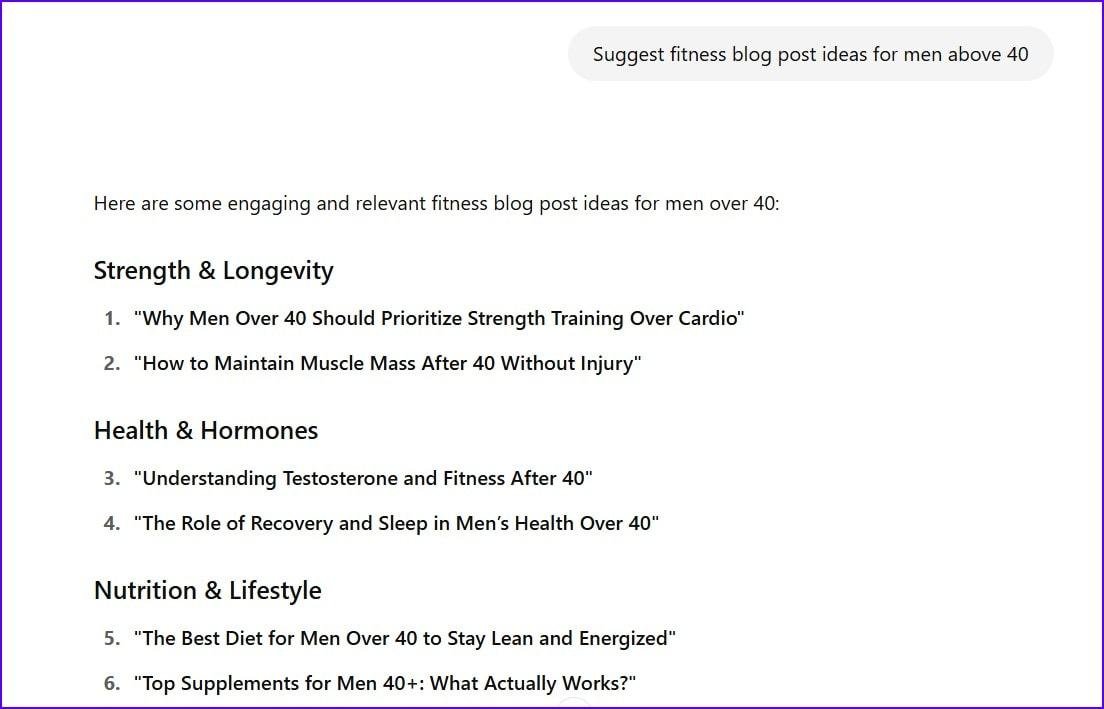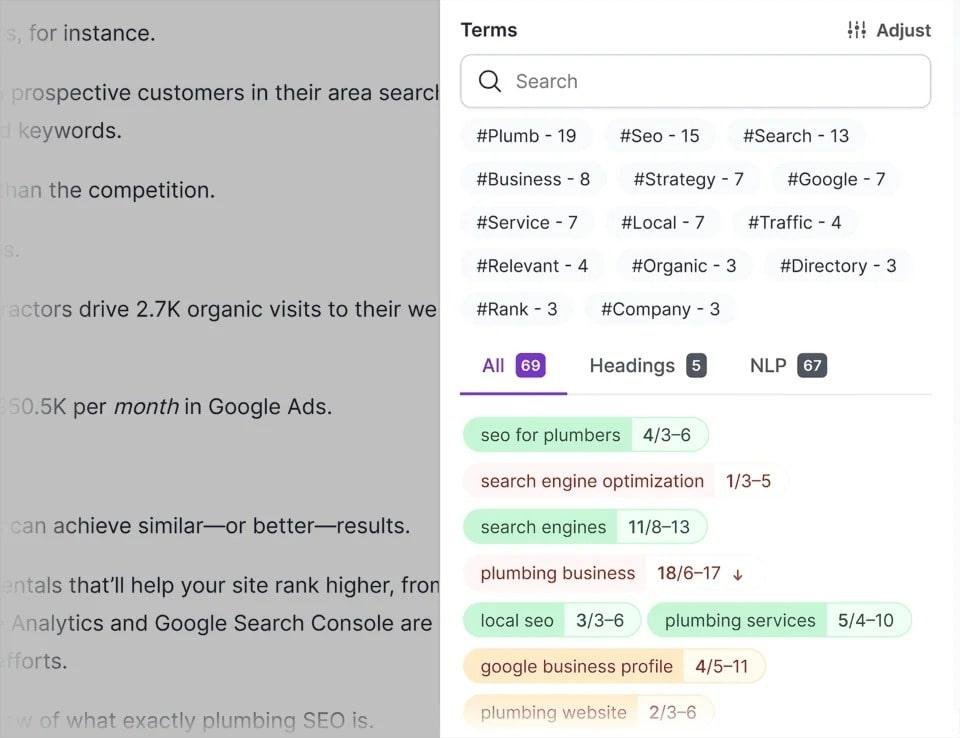Have you ever stared at a blank screen, wondering how to begin? It’s a struggle many bloggers face.
But what if you had a technology that could help brainstorm ideas, write drafts, or even refine your content?
Generative AI is a powerful tool in that regard. AI for blogging can assist you in various stages of the blogging process, from generating blog post ideas and conducting keyword research to drafting sections and optimizing for SEO.
So, in this post, I’ll walk you through how Generative AI can simplify your blogging workflow and enhance your content creation process.
Let’s dive in!
Disclaimer: If you buy any products through links on this site, I may earn a commission. But it doesn't make any difference to your cost, and it helps me keep this blog running. So you could always read my articles for free.
What is generative AI?
Generative AI refers to artificial intelligence that can create new content, such as text, images, or music.
Unlike traditional AI designed to analyze data, generative AI can generate original outputs based on learned patterns. It uses algorithms like deep learning and neural networks to understand and mimic human creativity.
Take GPT-4, for example, a text-based generative AI. It can write essays, answer questions, or even draft emails.
Another example is DALL·E, an AI that creates images from text prompts. With a simple input like “a cat on a skateboard,” DALL·E generates unique, high-quality images.

Generative AI has become valuable in various industries. For startups, tools like Jasper AI help create marketing copy efficiently. In media, AI-generated scripts or music can help streamline production.
Some businesses even use AI to develop personalized shopping experiences, recommending products based on customer preferences.
In short, these tools are transforming creative processes, saving time and resources.
However, the technology still faces challenges. There are concerns about ethical use, biases, and its potential to replace human jobs.
Why use AI for blogging
As a blogger or small business owner, you’re probably always looking for ways to make content creation easier and more efficient. That’s where AI comes in.
Whether you need help with brainstorming, editing, or structuring posts, AI enhances quality while saving time. Here’s how AI improves blogging for beginners and experienced writers alike.
Save time and effort
AI tools like Jasper and Copy.ai help generate blog post drafts faster. You can create outlines, intros, and conclusions quickly.
So, instead of spending hours brainstorming, AI can suggest topics and structures, making your blogging process smoother.
Related: Copy.ai review
Improve content quality
AI can help you create more polished content by suggesting improvements. For example, Grammarly is a great tool for checking grammar and style, while tools like Surfer SEO can help optimize your posts for search engines, ensuring your blog ranks higher in search results.
Related: Grammarly review
Establish consistency
Posting regularly builds audience trust and improves your SEO rankings. This is where AI-generated content helps—it keeps your blog active without causing burnout.
But that’s not all. AI tools help maintain a uniform tone and style across posts, which is essential for brands and businesses. Tools like Scalenut can help you schedule and automate content planning efficiently.
Boost creativity and inspiration
Sometimes, staring at a blank screen can block your creativity. AI can help by offering suggestions or drafting content that you can tweak. It doesn’t replace your creativity, but it gives you a solid starting point.
Overall, AI can be invaluable for creating quality content quickly without sacrificing creativity or consistency. It’s not about replacing your work—it’s about making it easier and more efficient.
Challenges of blogging with AI
While AI can be a helpful tool for bloggers, it’s not without its challenges. Here are a few things you might encounter when using AI for your blog.
Quality and originality concerns
AI can create decent content, but it often lacks the nuance, creativity, and originality that human writers bring.
While it can produce articles on almost any topic, the content can sometimes feel generic or formulaic. This impacts your blog’s readership.
SEO and engagement
You might expect AI to handle SEO effortlessly, but that’s not always the case. AI can miss keywords or context, which might affect your rankings.
Tools like Yoast or Surfer SEO are designed to help with this, but they still require you to tweak content for optimization.
On top of this, AI doesn’t always understand the full context of a topic. So you may need to revise or improve the content for higher engagement.
Ethical implications and trust
Another challenge with AI for blogging is transparency. Readers often appreciate knowing the content they read is human-written, especially for sensitive or personal topics.
AI-generated blogs can sometimes feel disconnected from a brand’s voice, leading to less trust from readers.
AI-generated news can lack the depth and accountability that readers expect from trusted sources.
Dependence on AI
While AI can save you time, over-relying on it can hinder your creativity. In fact, some businesses use AI so often that they stop brainstorming their own ideas.
So, the key is to use AI as a tool, not a crutch—use it to enhance your work, not replace it entirely.
Ultimately, AI can help with efficiency, but you’ll still need to put in the effort to ensure the content resonates with your audience.
How to use AI for blogging: top use cases
AI blogging has become a powerful tool for creating content quickly and efficiently. With the right approach, AI can help you generate ideas, write posts, and even optimize your content for better engagement.
So, understanding these use cases can save you time and boost your blogging efforts.
Generate blog post ideas
AI has quickly become a valuable tool for bloggers, especially when it comes to generating blog post ideas. For many, brainstorming fresh and engaging topics can be challenging. That’s where AI comes in.
AI tools like Jasper and Copy.ai are designed to help with idea generation. They can quickly analyze trends, industry news, and search data to provide blog post suggestions that are timely and relevant.
You can input a simple keyword or phrase, and these tools will suggest ideas tailored to your audience’s interests.
For example, if you run a fitness blog, asking ChatGPT for “fitness blog post ideas” might yield suggestions like “5 Home Workouts for Busy Professionals” or “How to Stay Motivated to Exercise in Winter.”

These ideas can be expanded further based on current health trends or seasonal interests.
But wait – there’s more.
Beyond generating topics, AI can also assist you in refining the direction of your content. For instance, if you run a food blog and want to write about “Healthy Meal Prep,” AI tools can help break down the broad topic into smaller, manageable subtopics.
You might get suggestions like “5 Easy Meal Prep Recipes for Busy Professionals” or “How to Meal Prep for Weight Loss.”
In the end, don’t forget to combine AI insights with your own creativity to craft unique and valuable content.
Conduct keyword research
Keyword research helps you discover what topics people are searching for, so you can create content that meets their needs. So that’s another application of AI for blogging.
AI-powered tools like Semrush and Ahrefs allow you to quickly identify high-traffic keywords relevant to your niche. By entering a simple keyword, these tools will provide a list of related terms, search volume, and competition levels.
For example, if you’re blogging about “healthy eating,” you might discover related terms like “meal prep ideas” or “plant-based recipes” with high search volume.
Aim to balance high-traffic keywords with lower-competition ones to create a mix that attracts traffic without making your content too competitive.
Another helpful tool is SurferSEO, which uses AI to analyze top-ranking pages for a specific keyword. It then gives you a list of keywords that are commonly used across those pages, helping you to improve your content’s SEO.
Determine search intent for your target keyword
Search intent defines why someone types a query into a search engine. AI tools help you analyze intent and create relevant content. Understanding intent improves rankings and user engagement.
Search intent falls into four types: informational, navigational, transactional, and commercial.
- Informational intent means the user is seeking knowledge, such as a tutorial or definition.
- Navigational intent indicates they are searching for a specific website or page.
- Transactional intent shows the user wants to make a purchase.
- Commercial investigation is when they are comparing options before buying.
For example, if someone searches “how does solar energy work,” they want information. On the other hand, if they search “Tesla Model 3 vs. Model Y,” they are comparing options.
AI-powered tools like Clearscope and SurferSEO analyze top-ranking pages to reveal intent patterns.
So, if most results are product pages, your blog should focus on product details, not just general information.
To optimize your blog, structure it based on intent. If targeting an informational query, provide step-by-step explanations. If it’s a transactional query, highlight benefits, comparisons, and calls to action.
Create a blog post outline
Creating a blog post outline is an essential step in organizing your thoughts and ensuring your content is clear and structured. AI tools can streamline this process, helping you generate outlines quickly and efficiently.
For example, if you want to write a post about “The Best Plant-Based Protein Sources,” an AI tool like Jasper or ChatGPT can help you structure your content.
You can simply input the topic, and the AI will provide a structured outline with headings and subheadings. It might suggest sections like an introduction to plant-based diets, a list of protein sources, and tips for incorporating them into meals.
AI helps you save time by organizing ideas into a logical flow. So, instead of spending hours brainstorming structure, you can focus on writing. On top of this, the AI can suggest topics you might not have considered but are relevant to your audience’s interests.
Here’s how to create a blog post outline using AI:
- Choose your topic: Think of a specific angle or focus for your post, like “Top 5 Plant-Based Protein Sources.”
- Use an AI tool: Input your topic into Jasper, ChatGPT, or any similar platform.
- Review suggested sections: AI will generate possible headings and subheadings. Refine these based on your target audience.
- Adjust to your style: Customize the outline to reflect your tone and brand voice.
With AI, creating a detailed, efficient outline becomes faster, so you can dive straight into writing.
Get drafts for each section of your post
Getting drafts for each section of your blog post is one of the most efficient ways to speed up your writing process and use AI for blogging.
AI tools can help you generate content quickly, allowing you to focus on refining your ideas instead of starting from scratch.
Let’s say you’re writing a post about “How to Plan a Memorable Road Trip.”
Once you’ve outlined your sections—Introduction, Planning Your Route, Packing Essentials, Road Trip Entertainment, and Safety Tips—you can use AI to generate drafts for each.
Once the drafts are generated, you can tweak and personalize the content to match your voice and tone.
Here’s how to get AI drafts for each section of your post:
- Create an outline: Break your post into sections like introduction, main points, and conclusion.
- Use an AI tool: Input each section’s topic into the tool (e.g., “Packing Essentials for a Road Trip”).
- Review and refine: AI will generate drafts and then you can edit them to ensure the content is accurate and fits your style.
For instance, for “Road Trip Entertainment,” AI might suggest listing activities like audiobooks, podcasts, or games, which you can expand on with your personal recommendations.
But don’t forget, AI drafts aren’t the final product—they’re a starting point. With good editing, you can turn them into polished, valuable content that inspires readers to hit the road with confidence.
Optimize blog post for SEO
Optimizing your blog posts for SEO is essential if you want your content to be found online.
AI tools streamline this process by analyzing search trends, keyword usage, and readability. So, instead of guessing what works, you can use AI-driven insights to refine your content.
For example, tools like SurferSEO can analyze top-ranking content for your target keyword and provide suggestions.

Also, if you’re writing about “beginner-friendly home workouts,” Jasper can suggest keyword variations like “easy exercises at home” or “best no-equipment workouts.” It can also help ensure that these keywords are placed naturally throughout the post.
Proofread and edit blog post drafts
Proofreading and editing your blog post drafts is a crucial step in ensuring your content is clear, engaging, and error-free. A well-edited post not only boosts your credibility but also helps keep readers engaged.
AI tools like Grammarly and ProWritingAid can help you catch mistakes, suggest improvements, and even refine your writing style.
These tools go beyond just checking spelling and grammar. They can analyze sentence structure, tone, and readability to ensure your content is clear and easy to follow.
By the time you’re done, your post will read more smoothly and be free of common errors.
Once your blog post is polished, you’ll be ready to publish content that’s professional and easy for your audience to read.
Best AI blogging tools
From generating ideas to refining your content, AI tools can help streamline the process. Let’s take a look at the best AI blogging tools that can make your writing smoother and more efficient.
Jasper (formerly Jarvis)
Jasper is a popular AI tool designed for generating high-quality blog content quickly.
It can help you write articles, product descriptions, and even social media posts.
By providing a few keywords or a brief prompt, Jasper can produce a complete draft, saving you hours of writing time.
It also comes with templates for different content types, like blog posts, emails, and landing pages. With its ability to understand tone and context, Jasper can create content that fits your brand’s voice.
For example, if you input a topic like “remote work productivity,” Jasper can create a well-structured post with multiple sections, tips, and recommendations.
Grammarly
Grammarly is a must-have tool for proofreading and editing your blog posts. This AI-powered tool scans your content for spelling and grammar errors, making suggestions for improvements in clarity, tone, and style.
Aside from that, it can even detect passive voice, redundant words, and inconsistencies. Whether you’re a beginner or an experienced blogger looking to use AI for blogging, Grammarly helps polish your writing, ensuring it is error-free and engaging.
For instance, after writing a blog post, you can paste it into Grammarly to catch overlooked mistakes, such as comma splices or awkward phrasing.
Surfer SEO
Surfer SEO is an AI tool that focuses on optimizing your blog post for search engines. It analyzes top-ranking content for your target keywords and suggests the best practices for on-page SEO.
Not just that, Surfer can help you choose the right keywords, structure your post effectively, and even optimize headings, meta descriptions, and internal links. Overall, this tool is perfect for bloggers who want to ensure their content performs well on Google.
For example, if you are writing a post on “healthy breakfast ideas,” Surfer SEO will provide keyword recommendations and tell you how many times to mention each keyword for optimal ranking.
Copy.ai
Copy.ai is a versatile content-generation tool that helps you with blog posts, emails, product descriptions, and more. You can choose from various templates based on the type of content you’re creating.
With its easy-to-use interface, Copy.ai makes it simple to get started and generate ideas quickly. It’s especially helpful when you’re struggling with writer’s block or need inspiration for fresh topics.
For example, if you’re unsure what to write about for a fitness blog, simply input keywords like “workout routines” and “weight loss,” and Copy.ai will generate several topic ideas and content drafts.
Rytr
Rytr is an AI writing assistant that helps you craft blog posts, social media content, and marketing copy. Rytr offers multiple writing tones, from professional to casual, and includes templates for different use cases.
It’s a great tool for bloggers who want to create content efficiently without sacrificing quality. Rytr can write drafts quickly, and you can easily adjust and refine the text afterward.
For example, for a post on “sustainable fashion,” Rytr can quickly generate an introduction, followed by several body paragraphs discussing eco-friendly clothing brands and how to shop sustainably.
Hemingway Editor
Hemingway Editor is an AI tool that focuses on making your writing concise and readable. It highlights overly complex sentences, passive voice, and hard-to-read text.
This tool is ideal for bloggers who want to write clear, direct content that’s easy to digest. Hemingway Editor also helps improve readability, which is essential for retaining your audience’s attention.
For instance, if you’re writing a post on “time management tips,” Hemingway will highlight sentences that can be simplified, such as changing “It is essential to prioritize your tasks every day” to “Prioritize your tasks daily.”
QuillBot
QuillBot is a paraphrasing tool that helps you rewrite content in a more engaging way. It uses AI to understand the meaning of sentences and suggests alternate phrasing. This can be useful for improving readability or avoiding repetition.
Overall, QuillBot is great when you need to rewrite a section of your post or create multiple versions of the same content.
For example, if you’re writing a post on “travel hacks,” QuillBot can reword your tips to add variety and keep the content fresh.
Writesonic
Writesonic is another AI-powered tool that helps you generate blog posts, articles, and ad copy. It’s known for its fast writing capabilities and ability to create long-form content. With a user-friendly interface and various templates, Writesonic is perfect for bloggers who need to produce content quickly and effectively.
For instance, if you’re writing about “digital nomad lifestyle,” Writesonic can generate sections about how to start, the challenges faced, and tips for thriving as a remote worker.
Final thoughts: don’t forget your personal touch
In the end, your content should always reflect your unique voice. Your role is to transform this content and make it uniquely yours during the editing process.
AI for blogging can help with structure and ideas, but it can’t replicate your knowledge, personal experiences, valuable lessons, individuality, and more.
Unless you supply the AI with a detailed account of your entire life, be sure to incorporate these components into your content to ensure the end result reflects your personal touch. Because no machine can understand your journey like you do.
The key is to blend the AI’s suggestions with your own insights, experience, and knowledge. This will make your content stand out and connect with your audience on a deeper level.
Did I miss anything? Did you try these tips? Do you have any questions or comments? Share your thoughts below in the comments section.





